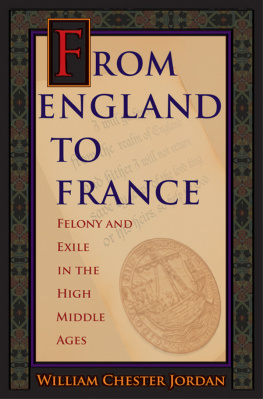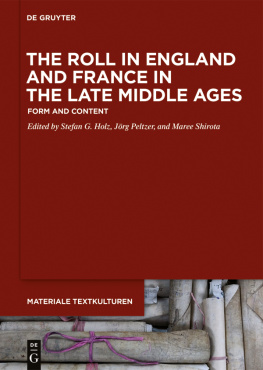
ROUTLEDGE LIBRARY EDITIONS:
HISTORY OF SEXUALITY
Volume 7
SEX IN THE MIDDLE AGES
SEX IN THE MIDDLE AGES
A Book of Essays
Edited by
JOYCE E. SALISBURY

First published in 1991 by Garland
This edition first published in 2019
by Routledge
2 Park Square, Milton Park, Abingdon, Oxon OX14 4RN
and by Routledge
52 Vanderbilt Avenue, New York, NY 10017
Routledge is an imprint of the Taylor & Francis Group, an informa business
1991 Joyce E. Salisbury
All rights reserved. No part of this book may be reprinted or reproduced or utilised in any form or by any electronic, mechanical, or other means, now known or hereafter invented, including photocopying and recording, or in any information storage or retrieval system, without permission in writing from the publishers.
Trademark notice: Product or corporate names may be trademarks or registered trademarks, and are used only for identification and explanation without intent to infringe.
British Library Cataloguing in Publication Data
A catalogue record for this book is available from the British Library
ISBN: 978-0-367-03102-2 (Set)
ISBN: 978-0-429-05663-5 (Set) (ebk)
ISBN: 978-0-367-17451-4 (Volume 7) (hbk)
ISBN: 978-0-429-05685-7 (Volume 7) (ebk)
Publishers Note
The publisher has gone to great lengths to ensure the quality of this reprint but points out that some imperfections in the original copies may be apparent.
Disclaimer
The publisher has made every effort to trace copyright holders and would welcome correspondence from those they have been unable to trace.
Sex in the Middle Ages
A Book of Essays
Joyce E. Salisbury

1991 Joyce E. Salisbury
All rights reserved
Library of Congress Cataloging-in-Publication Data
Salisbury, Joyce E.
Sex in the Middle Ages: a book of essays / Joyce E. Salisbur.
p. cm. (Garland reference library of the humanities; vol. 1360.
Garland medieval casebooks; vol. 3)
Includes index.
ISBN 0-8240-5766-X
1. Sex customsHistoryEurope. 2. EuropeSocial conditionsTo 1492. I. Title. II. 2. Series: Garland reference library of the humanities; vol. 1360. III. Series: Garland medieval casebooks; vol. 3.
| HQ14.S25 1991 | 91-3959 |
| 306.70940902dc20 | CIP |
Printed on acid-free, 250-year-life paper
Manufactured in the United States of America
To
Ziad-Aaron
CONTENTS
Andreas Heusler
[translated by Peter Nelson]
The credit for this book must go to the contributors. I appreciate the willingness of established and busy scholars to interrupt their research projects to write these essays contributing to the growing body of knowledge on sexuality. The talent represented in this book is matched by the intellectual generosity of these scholars.
Even with fine contributors, producing a work like this requires resolving a good of technical problems (converting programs and the like). I offer my thanks to Rita Logghe for helping me arrange all the details involved in bringing this work to press.
Finally, the dedication is for my new grandson who has brought the promise and fun of a new generation to all of us.
A definitive work synthesizing medieval beliefs about sexuality has not yet been written. While there have been many fine studies exploring aspects of the history of sexuality, we still seem as proverbial blind scholars describing the elephantine subject. In the Middle Ages, as now, sexuality included questions of biology, morality, sociology, and of course, passion. Thus, medievalists interested in sexuality study texts from science, theology, law, history, and literature. Each discipline brings certain insights into the expression of human sexuality. Whatever the discipline, it seems to me that studies of sexuality revolve around three main questions: What were people doing? What did they think about what they were doing? What did they think about what other people were doing? This collection of essays contributes to our understanding of medieval responses to these questions.
This collection draws scholars from many fields. Each essay is a specialized look at some aspect of sex in the Middle Ages approached from the perspective of a particular discipline. All address sexual practices and attitudes. By collecting these essays diverse in theme and method, I hope that the puzzle of medieval sexuality will be made a little more complete. In time, we will have a clearer picture of our sexual past that cannot help but influence our sexual present.
There are any number of ways to arrange such a collectionby discipline, chronology, geography, etc. I have chosen a thematic organization that will throw into focus certain facets of sexuality, and look at each from several perspectives.
Courtship
This seemed a reasonable place to begin a study of sexual intercourse. Jenny Jochens reminds us that physical attraction remains at the core of sexual attitudes and practices. Yet, our understandings of sexual attraction cannot be imposed uncritically on the past. In her essay, Before the Male Gaze, Professor Jochens carefully and creatively studies Old Norse texts to consider perceptions of corporal beauty which shaped interactions within that society. She discovers then, as now, the sight of the beloved was stirring. However, in contrast to modern texts, the Old Norse sources show that the female body was not the measure of sexual attractiveness. In the cold north, clothing, hair, and mens bodies drew the eye. Professor Jochens forces us to re-look at the glances that begin the sexual process.
Even glances expressive of mutual attraction did not always lead to fulfillment of sexual desire. Richard Kieckhefers article on Erotic Magic reminds us with wit and compassion that people will try almost anything to gain the objects of their desire. In an exhaustive survey of the practices of erotic magic, Professor Kieckhefer describes how people used natural magic, demonic magic, and magical use of religious objects to try to do everything from inducing someone to have sex to improving the sexual experience between consenting partners. In addition, Professor Kieckhefer describes the use of magic to prevent sexual intercourse and inclinations, and finally considers the literary tradition of erotic magic. The mind reels in contemplating all these recipes for sexual success, yet as one laughs at the images some of these conjure up, one cant help but wonder at the power of sexual attraction that would drive people to think of some of these techniques. Surely, it would be easier to find another partner.
One way or the other, people did come together. The first sexual experience of an individual, particularly a woman, was seen as transforming. Medieval societies from families to theologians valued virginity as a heavenly physical state. Esther Lastique and Helen Lemay edit, translate, and comment on a scientific treatise on the defloration of virginity. In A Medieval Physicians Guide to Virginity, Professors Lastique and Lemay show that defloration was considered a medical problem, unnatural and warranting medical intervention. Their analysis ranges far more widely than the text itself to consider the valuing of virgins in a larger context. Texts like these seem to point to a society in which sexual intercourse was seen as somehow unnatural. Perhaps such attitudes would contribute to people resorting to the recipes described by Professor Kieckhefer.
Next page









